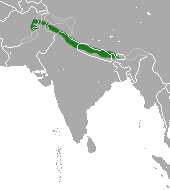Nepal gray langur
Appearance
(Redirected from Semnopithecus schistaceus)
| Nepal gray langur | |
|---|---|

| |
| Scientific classification | |
| Domain: | Eukaryota |
| Kingdom: | Animalia |
| Phylum: | Chordata |
| Class: | Mammalia |
| Order: | Primates |
| Suborder: | Haplorhini |
| Infraorder: | Simiiformes |
| Family: | Cercopithecidae |
| Genus: | Semnopithecus |
| Species: | S. schistaceus
|
| Binomial name | |
| Semnopithecus schistaceus | |

| |
| Nepal Gray Langur range | |
The Nepal gray langur (Semnopithecus schistaceus) is a gray langur endemic to the Himalayas in Nepal, far southwestern Tibet, northern India, northern Pakistan, Bhutan and possibly Afghanistan. It is found in forests at an elevation of 1,500 to 4,000 metres (4,900 to 13,100 ft).[1] Its easternmost limit in India is Buxa Tiger Reserve in northern West Bengal, at least up to the Rydak river.[3][4]
The Nepal gray langur is both terrestrial and arboreal and eats leaves.[1] At 26.5 kilograms (58 lb), the heaviest langur ever recorded was a male Nepal gray langur.[5]
References
- ^ a b c d Singh, M.; Kumara, H.N.; Yongcheng, L.; Chetry, D. & Kumar, A. (2020). "Semnopithecus schistaceus". IUCN Red List of Threatened Species. 2020: e.T39840A17942792. doi:10.2305/IUCN.UK.2020-2.RLTS.T39840A17942792.en. Retrieved 17 January 2022.
- ^ Groves, C. P. (2005). "Species Semnopithecus schistaceus". In Wilson, D. E.; Reeder, D. M. (eds.). Mammal Species of the World: A Taxonomic and Geographic Reference (3rd ed.). Baltimore: Johns Hopkins University Press. p. 174. ISBN 0-801-88221-4. OCLC 62265494.
- ^ Choudhury, A.U. (2007). "The eastern limit of distribution of the hanuman langur Semnopithecus entellus Dufresne". Journal of the Bombay Natural History Society. 104 (2): 199–200.
- ^ Choudhury, A.U. (2009). "Further changes in the eastern limit of distribution of the hanuman langur Semnopithecus entellus Dufresne". Journal of the Bombay Natural History Society. 106 (1): 90–91.
- ^ Brandon-Jones, D. (2004). "A taxonomic revision of the langurs and leaf monkeys (Primates: Colobinae) of South Asia". Zoos' Print Journal. 19 (8): 1552–1594. doi:10.11609/JoTT.ZPJ.971.1552-94.

